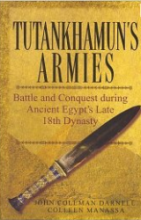Tutankhamun’s Armies: Battle and Conquest in Ancient Egypt’s Late 18th Dynasty

Tutankhamun may have been the boy king, but he had a lot of muscle behind him, as did his father Akhenaten, “the heretic king,” and their successors in the Eighteenth Dynasty. As you’ll discover in Tutankhamun’s Armies, the ancient Egyptian Empire could not and did not endure without two key elements: a strong king skilled in the physical arts of war as well as the mental disciplines of strategy and diplomacy; and a large, complex, and sophisticated armed force equipped with state-of-the-art weaponry for battle on land and sea.
Based on ancient Egyptian texts and diplomatic correspondence, inscriptions on stone monuments, and information gleaned, from a host of ancient artifacts and private tombs, this in-depth exploration of pharaoh’s army fills a yawning gap in our understanding of ancient Egyptian military history, and thus, the civilization as a whole.
Egyptologists John Darnell and Colleen Manassa develop a vivid picture of the forces, engagements, weaponry, strategies, tactics, and political machinations that characterized warfare during the Amarna period of the New Kingdom (1550-1335) B.C.E). It was a time when great empires vied for power and mighty kings and wily princes went to any length to secure alliances and destroy their enemies.
From the daily experiences of the common soldier to the strategic decision s of pharaoh and his top generals, this engaging chronicle examines every aspect of the military life of the period. It reveals how the nature of warfare was transformed by the arrival of two powerful new weapons, the chariot and the composite bow, and explores subtle differences in the Egyptians’ tactical approach depending on the nature and strength of the opposition, the terrain in which the conflict took place, and the political objective that Pharaoh hoped to achieve.